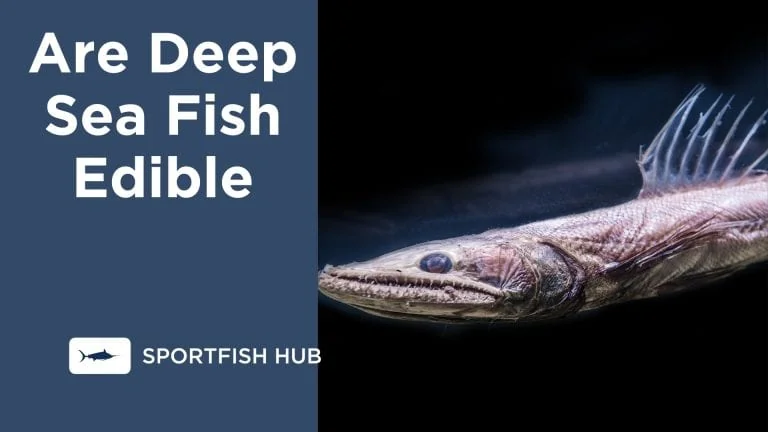Deep sea fish living in the ocean’s dark, cold depths are a unique and exotic food source. But can you eat Deep-Sea Fish? Let’s dive into the facts and see if you still want to put one of these fish on your dinner plate anytime soon.
You might also like reading: Why Do Deep Sea Fish Explode When Brought To The Surface?
Table of Contents
- What Are Deep Sea Fish?
- Can You Eat Deep-Sea Fish
- What Do Deep Sea Fish Taste Like?
- Deep Sea Fish: Sustainability Concerns
- FAQ
- What are some common cooking methods for deep-sea fish?
- What is the average size of deep-sea fish species?
- What gives some deep-sea fish a jelly-like texture?
- Are deep sea fish higher or lower in fat than surface fish?
- Conclusion
What Are Deep Sea Fish?
Deep sea fish live at depths below 200 meters in a zone known as the bathypelagic zone. Here there are no sunlight and very cold temperatures. Some examples of deep-sea fish include:
- Grenadiers
- Anglerfish
- Viperfish
- Lanternfish
These fish have adapted to the high pressure and lack of light, with large mouths, sharp teeth, and bioluminescent organs.
You might also be interested in reading: What is Deep Sea Fishing
Can You Eat Deep-Sea Fish
To answer the question directly: Yes, you can eat deep sea fish. Several species found in the deep sea are not only edible but also popular choices in many cuisines around the world.
Although no poisonous deep sea fish are used for human consumption, as with any wild fish, there are some health risks to consider:
- Parasites – Deep sea fish can harbor parasites like roundworms and tapeworms. Proper freezing and cooking of the fish mitigates this risk.
- Mercury – Large predatory deep-sea fish can accumulate mercury. Pregnant women and children should avoid high mercury fish like orange roughy.
- Scombroid Poisoning – Eating spoiled deep sea fish can cause a mild foodborne illness. Make sure the fish is very fresh.
- Radiation – Some deep sea fish from the Pacific may contain low levels of Fukushima radiation. The risk from this radiation is minor.
Also read: Are Deep Sea Fish Blind?
What Do Deep Sea Fish Taste Like?
The flesh of deep-sea fish is generally white, firm, and lean. The flavor varies greatly by species but is typically described as having a mild sweet flavor. Some popular deep-sea eats include:
| Fish Species | Description | Taste | Uses |
|---|---|---|---|
| Grenadier | Abundant species, also called rat-tails | Mild, flaky, lean flesh | Fillet, soup, fish cake |
| Orange Roughy | Bright reddish fish found near Australia and New Zealand | Sweet, delicate flavor | Baked, poached, grilled |
| Anglerfish | Named for the glowing “fishing pole” on its head | Lean white fillets, rich liver | Fillets fried or baked; liver sautéed |
| Snailfish | Gelatinous flesh due to high pressure | Mild, firm texture | Stews, smoked fish dip |
| Lanternfish | Bioluminescent species found worldwide | Flavor similar to cod | Fried, dried, in fishcakes |
| Dory | Found in deep oceans worldwide | Lean, firm, flaky meat | Baked, fried, tacos, sandwiches |
| Sablefish | Also called black cod, found in North Pacific | Buttery, rich flavor | Smoked, grilled, poached, baked |
| Escolar | Waxy, oily flesh causes digestion issues if eaten in large amounts | Delicate, flaky, buttery | Baked, grilled, served in moderation |
| Oilfish | Named for its very high wax ester content | Flavor comparable to escolar | Fried, baked, often disguised as other fish |
| Elasmobranchs | Includes deep sea sharks and rays | Firm, dense texture | Grilled, broiled, |
Deep Sea Fish: Sustainability Concerns
Deep sea fish have slow growth rates and late maturity ages, which makes them highly susceptible to overfishing. When choosing to eat deep sea fish, it’s important to ensure the species has been sustainably sourced. Organizations such as the Marine Stewardship Council (MSC) provide certification for sustainable seafood, aiding consumers in making environmentally conscious choices.
FAQ
-
What are some common cooking methods for deep-sea fish?
Deep sea fish hold up well to most cooking methods, including baking, broiling, pan frying, and grilling. Their lean flesh tends to stay moist when cooked.
-
What is the average size of deep-sea fish species?
Most deep sea fish are small, under 1 foot long. But some like the giant oarfish can reach lengths of 30 feet.
-
What gives some deep-sea fish a jelly-like texture?
The high pressures in the deep ocean causes the proteins in their flesh to become gelatinous. This gives some species like blobfish a jelly-like texture.
-
Are deep sea fish higher or lower in fat than surface fish?
Deep sea fish are very low fat, even lower fat than common surface fish like tuna or salmon.
Conclusion
The Verdict on Eating Deep Sea Fish With sustainable choices, deep sea fish can be a tasty, healthy protein source. Their unique flavors and nutrition make them an intriguing addition to any seafood-lovers diet. Just take precautions to minimize risks from parasites and mercury exposure when eating fish from the deep.












